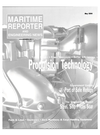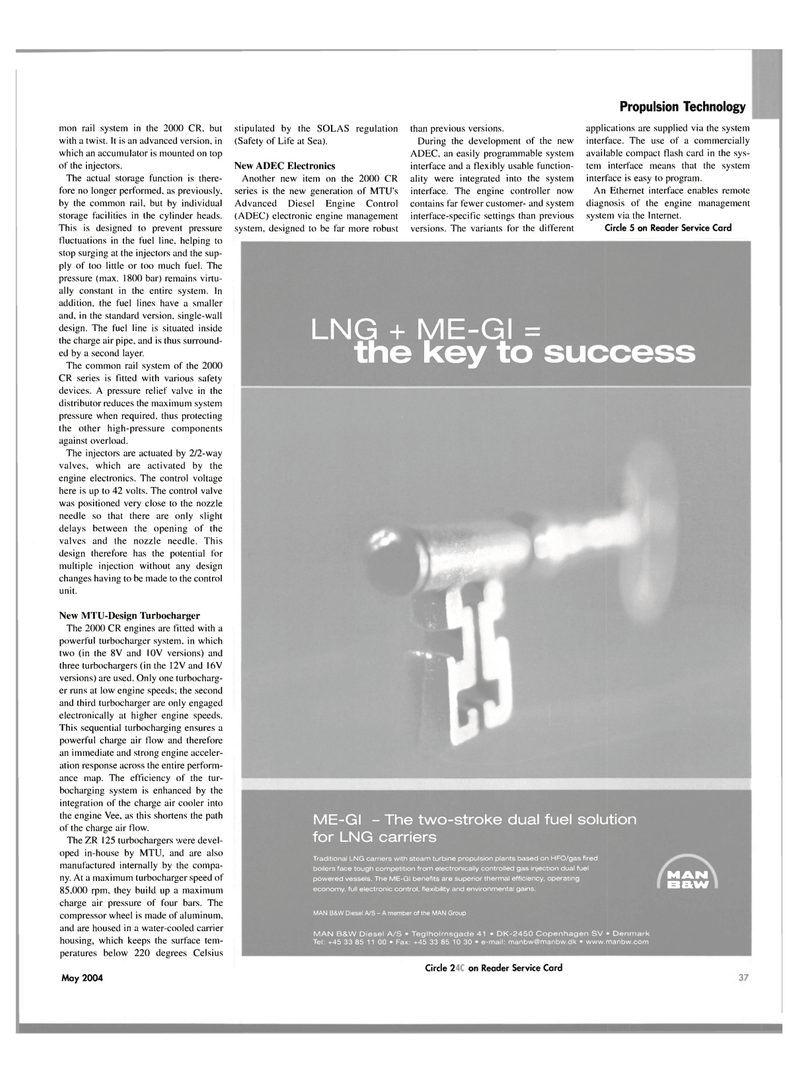
Page 41: of Maritime Reporter Magazine (May 2004)
The Propulsion Technology Yearbook
Read this page in Pdf, Flash or Html5 edition of May 2004 Maritime Reporter Magazine
Propulsion Technology mon rail system in the 2000 CR, but with a twist. It is an advanced version, in which an accumulator is mounted on top of the injectors.
The actual storage function is there- fore no longer performed, as previously, by the common rail, but by individual storage facilities in the cylinder heads.
This is designed to prevent pressure fluctuations in the fuel line, helping to stop surging at the injectors and the sup- ply of too little or too much fuel. The pressure (max. 1800 bar) remains virtu- ally constant in the entire system. In addition, the fuel lines have a smaller and, in the standard version, single-wall design. The fuel line is situated inside the charge air pipe, and is thus surround- ed by a second layer.
The common rail system of the 2000
CR series is fitted with various safety devices. A pressure relief valve in the distributor reduces the maximum system pressure when required, thus protecting the other high-pressure components against overload.
The injectors are actuated by 2/2-way valves, which are activated by the engine electronics. The control voltage here is up to 42 volts. The control valve was positioned very close to the nozzle needle so that there are only slight delays between the opening of the valves and the nozzle needle. This design therefore has the potential for multiple injection without any design changes having to be made to the control unit.
New MTU-Design Turbocharger
The 2000 CR engines are fitted with a powerful turbocharger system, in which two (in the 8V and 10V versions) and three turbochargers (in the 12V and 16V versions) are used. Only one turbocharg- er runs at low engine speeds; the second and third turbocharger are only engaged electronically at higher engine speeds.
This sequential turbocharging ensures a powerful charge air flow and therefore an immediate and strong engine acceler- ation response across the entire perform- ance map. The efficiency of the tur- bocharging system is enhanced by the integration of the charge air cooler into the engine Vee, as this shortens the path of the charge air flow.
The ZR 125 turbochargers were devel- oped in-house by MTU, and are also manufactured internally by the compa- ny. At a maximum turbocharger speed of 85,000 rpm, they build up a maximum charge air pressure of four bars. The compressor wheel is made of aluminum, and are housed in a water-cooled carrier housing, which keeps the surface tem- peratures below 220 degrees Celsius
May 2004 39 stipulated by the SOLAS regulation (Safety of Life at Sea).
New ADEC Electronics
Another new item on the 2000 CR series is the new generation of MTU's
Advanced Diesel Engine Control (ADEC) electronic engine management system, designed to be far more robust than previous versions.
During the development of the new
ADEC, an easily programmable system interface and a flexibly usable function- ality were integrated into the system interface. The engine controller now contains far fewer customer- and system interface-specific settings than previous versions. The variants for the different applications are supplied via the system interface. The use of a commercially available compact flash card in the sys- tem interface means that the system interface is easy to program.
An Ethernet interface enables remote diagnosis of the engine management system via the Internet.
Circle 5 on Reader Service Card
LNG + ME-GI = the key to success
ME-GI - The two-stroke dual fuel solution for LNG carriers
Traditional LNG carriers with steam turbine propulsion plants based on HFO/gas fired boilers face tough competition from electronically controlled gas injection dual fuel powered vessels. The ME-GI benefits are superior thermal efficiency, operating economy, full electronic control, flexibility and environmental gains.
MAN
B&W
MAN B&W Diesel A/S - A member of the MAN Group
MAN B&W Diesel A/S • Teglholrnsgade 41 • DK-2450 Copenhagen SV • Denmark
Tel: +45 33 85 11 00 • Fax: +45 33 85 10 30 • e-mail: [email protected] • www.manbw.com
Circle 271 on Reader Service Card

 40
40

 42
42
